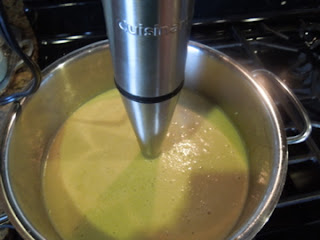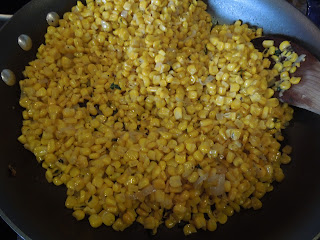Lots of Food and Company to be Thankful for
I’ve discovered that there are many more international readers of my blog than I had expected, and there were visits to this site—just this week alone—by readers from Australia, Ireland, United Arab Emirates, Philippines, Canada, Brazil, and the United Kingdom in addition to the preponderance of readers in the United States. So, perhaps not everyone perusing this page would know that yesterday was Thanksgiving Holiday in the United States. (But, yes, that is the reason why this post is updating a little later than usual on a Friday.)
In the exhausted aftermath of the whirlwind of activities,
here are some thoughts I have about the preparation for (and serving of) our Thanksgiving meal yesterday.
1. Make sure that the
pre-dinner appetizers are relatively light—and elegant!
We all know that there is a lot of eating to be done between
Thanksgiving and New Year. Snacks before
dinner are de rigueur—while we wait
for everyone to get to dinner and for the last-minute preparations to
conclude—but we also don’t need to be consuming too much. What we really don’t need are huge bowls of
chips and dips which will spoil our appetites for dinner while adding nothing
to our culinary experience.
For carbs, I set out a pint glass of garlic breadsticks and
a small plate of olive oil and sea salt water crackers. Otherwise, snacks consisted of Pepperdew
peppers (small, round, sweet, with a slight kick) stuffed with a mild creamy
Chevre goat cheese; a tiny mound of baba ganoush with a sprinkling of smoked paprika and
drizzle of olive oil; and Castelvetrano olives and feta cheese marinated with
Piquillo pepper strips, garlic, herbs and olive oil.
2. Use an immersion
hand-blender for creamy soups.
We love our Vitamix and use it to make smoothies, almond
milk, and slushy drinks. But I never
listen to recipe directions to cool down your hot soup and then use a blender
to puree a creamy soup and then reheat the soup. If the soup is going to be served cold anyway
I might use the blender, but hot soups stay hot in our kitchen by being pureed
with a hand-blender.
Our Thanksgiving dinner’s first course was a Curried Cream
of Cauliflower Soup garnished with—at the table—the guest’s choice of
crystallized ginger or chopped chives (pictured at the top of this post).
Those who tried both said that the chives were more visually striking
but that the ginger added a much more distinctive taste. The ginger adds a healthy dose of a little heat and bite to the soup and picks up the curry flavor well.
3. Check on the dry
brine of your bird.
We roast chickens often and rely on them as a staple in our
kitchen. Although we don’t actually use
a recipe anymore, we started by using one which directed us to dry-brine the
chicken for many hours with a prodigious amount of salt mixed with ground black
pepper and chopped thyme. We rarely use
the full amount of salt anyway (since they suggest a staggering 3 tablespoons
of salt per a 3½ pound bird), and didn’t do so again this time. Yet I noticed something slightly odd this
time around when the salt didn’t seem to be dissolving as per usual while
sitting in the refrigerator.
Normally, much of the salt dissipates into the skin and the
flesh—thus producing a lovely tender roast bird—but the salt didn’t seem to
dissolve this time. I wished that I had
followed my instinct and brushed off the excess salt before (during, or even
after!) cooking. While the birds were
extremely tender as usual, the skin was also extraordinarily salty. All our guests, being polite, declared the
chicken wonderful and flavorful, but I suspect we all thought that the chickens
were too salty.
Afterwards, Will and I wondered whether the fact that the
chickens we got were Kosher might have something to do with this salt
issue. Are Kosher chickens packed in
salt and therefore already have a higher salt content? We were both convinced that we had used
Kosher chickens before for our roast chickens, but perhaps we were preparing
them a different way. In fact, if anyone
knows the answer to our question, please send an email or a comment.
4. “Choice” is plenty good enough for a tenderloin roast.
Will and I have decided not to consume too much red meat, but when a special occasion calls for beef we like to purchase “Prime” meat when possible. Our experience taught us that “Prime” steaks
are so much better and more subtly marbled—and thus flavorful and tender. This Thanksgiving, we could not find a
“Prime” roast at our usual meat source, so we settled for “Choice.” Since we were planning on bacon-wrapping the
roast and then char-grilling it, perhaps “Choice,” especially in a cut like a
tenderloin, would suffice. We hoped.
The tenderloin was a huge hit. Not only was it grilled perfectly—outside, on
the patio, in late November, by Will—but the meat itself was so tender, even in
the more well-done end parts. Really, it
cut like butter. (In fact, see how great it looks the next day, cut for leftovers in the picture above.) We offered salt and
pepper, but no one took any. The bit of
salt and smoke from bacon-wrap and the chargrilling gave the perfect amount of
flavor—and reminded many of us why we might not want to become vegetarian any
time too soon…
5. Offer plenty of veggie
side dishes to atone for the meat-fest.
To complete the rest of the menu, we had:
*Roasted root vegetable salad with Gorgonzola, toasted walnuts, and balsamic glaze
*Shredded caramelized Brussels sprouts with toasted pecans
*Buttermilk chive mashed potatoes
*Caramelized corn with shallots and thyme
*Romaine and persimmon salad with a light sesame citrus
vinaigrette
*Buttermilk rosette rolls (Will’s specialty at Thanksgiving)
*Pecan and Apple pies (courtesy of our friend Debra)
Another Thanksgiving is done with, and we have plenty of
leftovers to ensure that we won’t have to cook again until the end of my
term. Yet another reason to be thankful!










Comments
Post a Comment